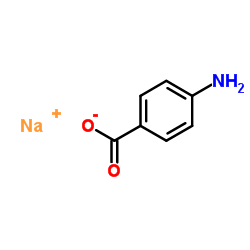Sodium 4-aminobenzoate

Sodium 4-aminobenzoate structure
|
Common Name | Sodium 4-aminobenzoate | ||
|---|---|---|---|---|
| CAS Number | 555-06-6 | Molecular Weight | 159.118 | |
| Density | N/A | Boiling Point | 339.9ºCat 760 mmHg | |
| Molecular Formula | C7H6NNaO2 | Melting Point | >300 °C(lit.) | |
| MSDS | Chinese USA | Flash Point | 159.4ºC | |
| Symbol |

GHS07 |
Signal Word | Warning | |
|
Carbonic anhydrase inhibitors. Inhibition of the β-class enzymes from the fungal pathogens Candida albicans and Cryptococcus neoformans with branched aliphatic/aromatic carboxylates and their derivatives.
Bioorg. Med. Chem. Lett. 21 , 2521-6, (2011) The inhibition of the β-carbonic anhydrases (CAs, EC 4.2.1.1) from the pathogenic fungi Cryptococcus neoformans (Can2) and Candida albicans (Nce103) with a series of 25 branched aliphatic and aromatic carboxylates has been investigated. Human isoforms hCA I a... |
|
|
Carboxymethylcellulose-tetrahydrocurcumin conjugates for colon-specific delivery of a novel anti-cancer agent, 4-amino tetrahydrocurcumin.
Eur. J. Pharm. Biopharm. 88(2) , 351-60, (2014) Several curcumin derivatives are now becoming increasingly of interest because of their bioactive attributes, especially their action as antioxidants and anti-carcinogenic activities. Tetrahydrocurcumin (THC), an active metabolite of curcumin, was selected to... |
|
|
Determination of ultraviolet filters in bathing waters by stir bar sorptive-dispersive microextraction coupled to thermal desorption-gas chromatography-mass spectrometry.
Talanta 147 , 246-52, (2015) In this work, a new approach that combines the advantages of stir bar sorptive extraction (SBSE) and dispersive solid phase extraction (DSPE), i.e. stir bar sorptive-dispersive microextraction (SBSDµE), is employed as enrichment and clean-up technique for the... |
|
|
Towards an understanding of the nucleation of alpha-para amino benzoic acid from ethanolic solutions: a multi-scale approach.
Faraday Discuss. 179 , 79-114, (2015) The molecular assembly and subsequent nucleation of para-amino benzoic acid (PABA) from ethanolic solutions is probed using a multi-scale and multi-technique approach. This is applied by examining and interrelating information regarding the molecular, solutio... |
|
|
Comparison of xenobiotic metabolizing enzyme activities in ex vivo human skin and reconstructed human skin models from SkinEthic.
Arch. Toxicol. 88(9) , 1681-1694, (2014) Skin function is not limited to a physical barrier. According to its total surface area, it is also considered as an extra-hepatic metabolizing organ. In vitro engineered human skins have been developed to replace limited ex vivo normal human skin samples (NH... |
|
|
LC-APCI-MS/MS Quantification and Topical Bioavailability of Chloroacetamide in Rats.
J. Chromatogr. Sci. 53 , 1100-6, (2015) Chloroacetamide (CAA) is a preservative used in various cosmetic, personal care and household products. Due to the hazard potential for allergic reaction and reproductive toxicity, CAA is being considered a high priority for screening assessment and toxicolog... |
|
|
Re-inoculation strategies enhance the degradation of emerging pollutants in fungal bioaugmentation of sewage sludge.
Bioresour. Technol. 168 , 180-9, (2014) The use of Trametes versicolor has been partially successful in the removal of some pharmaceuticals from sewage sludge in laboratory-scale biopile systems. The application of two strategies for the re-inoculation of biomass was assessed during the fungal bioa... |
|
|
Arylamine N-acetyl Transferase (NAT) in the blue secretion of Telescopium telescopium: xenobiotic metabolizing enzyme as a biomarker for detection of environmental pollution.
Springerplus 3 , 666, (2015) Telescopium telescopium, a marine mollusc collected from Sundarban mangrove, belongs to the largest mollusca phylum in the world and exudes a blue secretion when stimulated mechanically. The blue secretion was found to metabolize (preferentially) para-amino b... |
|
|
Sulfated low molecular weight lignins, allosteric inhibitors of coagulation proteinases via the heparin binding site, significantly alter the active site of thrombin and factor xa compared to heparin.
Thromb. Res. 134(5) , 1123-9, (2014) Sulfated low molecular weight lignins (LMWLs) have been found to bind in the heparin binding sites of coagulation proteinases. LMWLs represent a library of diverse non-carbohydrate, aromatic molecules which are structures different from heparin, but still pot... |
|
|
A Coxiella-like endosymbiont is a potential vitamin source for the Lone Star tick.
Genome Biol. Evol. 7 , 831-8, (2015) Amblyomma americanum (Lone star tick) is an important disease vector in the United States. It transmits several human pathogens, including the agents of human monocytic ehrlichiosis, tularemia, and southern tick-associated rash illness. Blood-feeding insects ... |